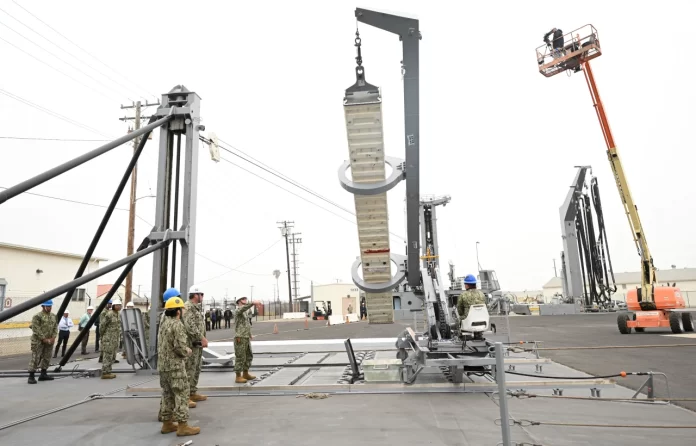Ensuring the loading (reloading) of munitions, including missiles, onto ships is a critical task in the operation of naval anti-aircraft missile complexes (SAMs) of the Navy. The efficiency, safety, and timeliness of this process affect the ability to maintain the ship’s armament at the required level of readiness.
The US Navy is testing a new device called the Transferrable Rearming device (TRAM) to allow for reloading vertical launch missile (VLS) cells on ships at sea. The Naval Surface Warfare Center Port Hueneme Division developed TRAM, which uses an articulated crane to lift and spin a missile canister vertically before lowering it into the launcher cell.
The Naval Surface Warfare Center (NSWC), Port Hueneme Division, has completed the first land-based tests of the mechanism designed to reload the US Navy’s Vertical Launch System (VLS) at sea.
In 2023, Secretary of the Navy Carlos Del Toro indicated at the American Society of Naval Engineers’ Combat Systems Symposium that reloading VLS at sea is a “high priority.” In his speech, he also mentioned TRAM, a 20-year-old innovation that allows ships to reload their missile batteries while underway for the first time. Although cranes had previously been used on Ticonderoga-class cruisers and early Arleigh Burke-class destroyers, they were deemed unsuitable and unsafe due to concerns with relative movement.
The Navy expects that TRAM will help it overcome these obstacles. Rich Hadley, director of the replenishment department at NSWC Port Hueneme, stated in a test press release that solving TRAM’s key relative motion issues allows for transfer operations during high-seas work, significantly increasing the fleet’s logistical flexibility, resilience, and firing rate far from bases.
TRAM, designed in-house by the NSWC Port Hueneme Division for reloading VLS in sea state 5 circumstances (with waves up to 4 meters high), employs an articulated crane to raise and rotate the missile container vertically before lowering it into the launch system. Currently, US Navy ships must return to port to refill VLS when their missile stores are depleted or reduced. The Navy has traditionally used cranes to execute VLS reloading dockside, necessitating warships to make lengthy trips to port for missile resupply. The MK 41 VLS was initially intended with a crane for at-sea reloading, but it proved difficult to operate and was eventually retired.
Lessons from the Red Sea incidents and concerns about future conflicts in the Indo-Pacific region have raised the demand for missile reloading since the concept’s inception in 2022. The system’s development moved swiftly, and in December 2023, a test site was created at NSWC Port Hueneme. This display was executed flawlessly within the Secretary of State’s tight timeframes. This surface warfare revolution will strengthen the US Navy’s existing fleet’s continual frontline presence and lethality, producing a new powerful short-term deterrent that will disturb our opponents’ strategic calculations, said Steve Brock, Senior Advisor to the Secretary of the Navy.
While exact TRAM characteristics are unknown, statements from the Secretary of the Navy and photos of the Port Hueneme land-based test complex indicate that the system requires transporting missiles from a supply ship to a warship. Rich Hadley said TRAM will allow ships to reload missiles simply as they refuel—using a connected replenishment system at high speed and in the open ocean. Unlike the previous crane, missile containers will be attached to the crane during reloading.
During the testing, the US Navy’s Naval Sea Systems Command instructed sailors from the USS Chosin (CG-65) and an expeditionary reloading company, who were monitored on-site using instruments.
According to Naval News, although the system’s sea trials, which are slated for the fall, have yet to be completed, the data obtained during these testing will be actively exploited.
The Navy has allocated $3.9 million in FY2023 and $12.4 million in FY2024 for the development and testing of TRAM. Secretary Del Toro has declared that TRAM will be a “game-changing capability” that will enhance the surface navy’s strength and function as a potent maritime deterrent within the next two to three years.
Nevertheless, the deployment of at-sea rearming ships would entail risks, and escorts would be necessary to safeguard them in forward areas.
Russia has also attempted to deploy munitions at sea; however, it has since determined that this is impractical. The Russian Navy tried to operationally replenish munitions at sea in unequipped anchorages during combat operations in the Syrian Arab Republic.
The Russian Navy’s loading methods were ineffectual in addressing the challenge of supplying missile and explosive munitions to the heavy aircraft-carrying cruiser “Admiral Kuznetsov.” Consequently, a self-propelled mobile crane SPK-46160, which is predominantly intended for coastal operations, was transported from Sevastopol to the Syrian coast. It is uncertain whether the safety measures outlined in the guiding documents were followed during this procedure, as the crane is not intended for the secure transfer of munitions during open sea operations.
Additionally, the Russians discovered that numerous loading methods approved for service in recent years are not capable of safely and efficiently loading munitions at the base.
For example, the Russian Navy has acquired Project 20380 and 22350 vessels outfitted with the most recent “Polyment-Redut” air defense systems, including VLS. The missiles are loaded into these VLS using transport-launch containers (TLC) that are fitted with a loading apparatus. The practice has shown that this loading equipment is not optimal, as it is inconvenient to operate and unsafe. Excluding the time necessary to prepare the loading equipment, transport logistics, and offload empty TLCs, it takes approximately eight hours to transfer a complete set of missiles onto a Project 20380 ship in calm water.
These metrics are significantly lower than those of the US Navy, which, for instance, requires approximately three hours to deploy the same number of missiles onto a Ticonderoga-class cruiser, which is four times less time.






